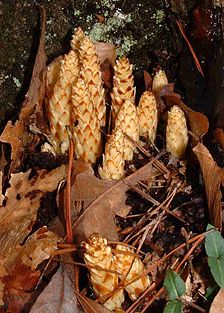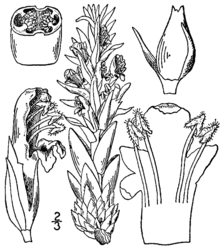- Conopholis americana
-
Conopholis americana 
American cancer-root Scientific classification Kingdom: Plantae (unranked): Angiosperms (unranked): Eudicots (unranked): Asterids Order: Lamiales Family: Orobanchaceae Tribe: Orobancheae[1] Genus: Conopholis Species: C. americana Binomial name Conopholis americana
(L.) Wallr.[2]
Range of Conopholis americana Synonyms Orobanche americana L.[3]
Conopholis americana, American cancer-root or squawroot or bear corn, is a perennial,[4] non-photosynthesizing (or "achlorophyllous") parasitic plant, from the family Orobanchaceae and more recently from the genus Conopholis but also listed as Orobanche, native but not endemic to North America and when blooming, resembles a pine cone or cob of corn growing from the roots of mostly oak and beech trees.[5][6]
Contents
Description
C. americana is parasitic on the roots of woody plants, especially oaks (genus Quercus) and beech (genus Fagus).[4] The only part of the plant generally seen is the cone-shaped inflorescence,[6] which appears above ground in spring.[7] The entire structure is a yellowish color, turning to brown[4] and achieves heights of 10 centimeters (4 in) to 20 centimeters (8 in) tall.[8]
Stems and leaves
Stout and unbranched 1.3 centimeters (0.5 in) to 2.5 centimeters (1.0 in) thick stems.[9] Since C. americana does not photosynthesize[6] it also does not have true leaves; it has instead simple, ovate, tiny scales[4] 1.3 centimeters (0.5 in) long and brown, which appear underneath each flower.[8]
Flowers
C. americana produces spikes of yellow to cream flowers densely crowded all around the stem.[8] Each flower is 5-parted, 8 millimeters (0.3 in) to 13 millimeters (0.5 in) long, tubular with a swollen base and facing downwards.[9] As the flowering spike matures and begins to wither and becomes brown throughout the summer and often persisting through the winter, by which time it has become shriveled and black. There is no noticeable floral scent.[8]
Fruits and reproduction
Each flower is replaced by a seed capsule that is longer than it is wide and contains many small seeds. This plant spreads to new locations by reseeding itself.[8]
Roots
The root system is parasitic on the roots of Oak trees (Quercus spp.); dependent on the host tree for its nourishment, the suckers of the parasitic roots cause the formation of large rounded knobs on the roots of the host tree.[8]
Distribution
Found growing on roots in wooded ravines[4] in every state of the United States east of the Mississippi River.[2]
Native:
- Nearctic:
- Northern America:
- Eastern Canada: Nova Scotia, Ontario, Quebec
- Northeastern U.S.A.: Connecticut, Indiana, Maine, Massachusetts, Michigan, New Hampshire, New Jersey, New York, Ohio, Pennsylvania, Rhode Island, Vermont, West Virginia
- North-Central U.S.A.: Illinois, Wisconsin
- Southeastern U.S.A.: Alabama, Delaware, Florida, Georgia, Kentucky, Maryland, North Carolina, South Carolina, Tennessee, Virginia[3]
- Northern America:
It is considered an exploitably vulnerable species in New York, a threatened species in New Hampshire and a special concern in Rhode Island.[2]
References
- ^ UniProt Consortium. "Species Conopholis americana (Squawroot) (Orobanche americana)". http://beta.uniprot.org/taxonomy/4179. Retrieved 2008-04-13.
- ^ a b c Natural Resources Conservation Service (NRCS). "PLANTS Profile, Conopholis americana". The PLANTS Database. United States Department of Agriculture,. http://plants.usda.gov/java/profile?symbol=COAM. Retrieved 2008-04-13.
- ^ a b Germplasm Resources Information Network (GRIN) (2004-03-31). "Taxon: Conopholis americana (L.) Wallr.". Taxonomy for Plants. USDA, ARS, National Genetic Resources Program, National Germplasm Resources Laboratory, Beltsville, Maryland. http://www.ars-grin.gov/cgi-bin/npgs/html/taxon.pl?417496. Retrieved 2008-04-13.
- ^ a b c d e David Ketzner and Jeanne Karnes. "ILPIN INFORMATION ON Conopholis americana". ILLINOIS PLANT INFORMATION NETWORK. United States Forest Service. http://www.fs.fed.us/ne/delaware/ilpin/839.co. Retrieved 2008-04-13.
- ^ Grafton, Emily. "Beech Drops" (PDF). PNPS Notes Quarter #4. Pennsylvania Native Plant Society. http://www.pawildflower.org/01_articles/Notes_2005_Q4.pdf. Retrieved 2008-04-10.[dead link]
- ^ a b c C. Vandaveer (2005-06-27). "Plant of the Week". http://www.killerplants.com/plant-of-the-week/20050627.asp. Retrieved 2008-04-10.
- ^ "Squawroot Conopholis americana". Connecticut Wildflowers. Connecticut Botanical Society. 2008-03-07. http://www.ct-botanical-society.org/galleries/conopholisamer.html. Retrieved 2008-04-13.
- ^ a b c d e f John Hilty. "Cancer Root Conopholis americana". Illinois Wildflowers. http://www.illinoiswildflowers.info/woodland/plants/cancer_root.htm. Retrieved 2008-04-13.
- ^ a b University of Wisconsin–Stevens Point. "Conopholis americana (L.) Wallr.". Robert W. Freckmann Herbarium. http://wisplants.uwsp.edu/scripts/detail.asp?SpCode=CONAME. Retrieved 2008-04-13.
External links
 Data related to Conopholis americana at Wikispecies
Data related to Conopholis americana at Wikispecies  Media related to Conopholis americana at Wikimedia Commons
Media related to Conopholis americana at Wikimedia Commons- "Conopholis americana". Integrated Taxonomic Information System. http://www.itis.gov/servlet/SingleRpt/SingleRpt?search_topic=TSN&search_value=34274. Retrieved 13 March 2008.
Categories:- Orobanchaceae
- Wildflowers of the Great Smoky Mountains
- Flora of Appalachia (United States)
- Flora of the Great Lakes region (North America)
- Flora of the Eastern United States
- Flora of Nova Scotia
- Flora of Ontario
- Flora of Quebec
- Flora of Connecticut
- Flora of Indiana
- Flora of Maine
- Flora of Massachusetts
- Flora of Michigan
- Flora of New Hampshire
- Flora of New Jersey
- Flora of New York
- Flora of Ohio
- Flora of Pennsylvania
- Flora of Rhode Island
- Flora of Vermont
- Flora of West Virginia
- Flora of Illinois
- Flora of Wisconsin
- Flora of Alabama
- Flora of Delaware
- Flora of Florida
- Flora of Georgia (U.S. state)
- Flora of Kentucky
- Flora of Maryland
- Flora of North Carolina
- Flora of South Carolina
- Flora of Tennessee
- Flora of Virginia
- Flora of Washington, D.C.
- Lamiales stubs
- Nearctic:
Wikimedia Foundation. 2010.


